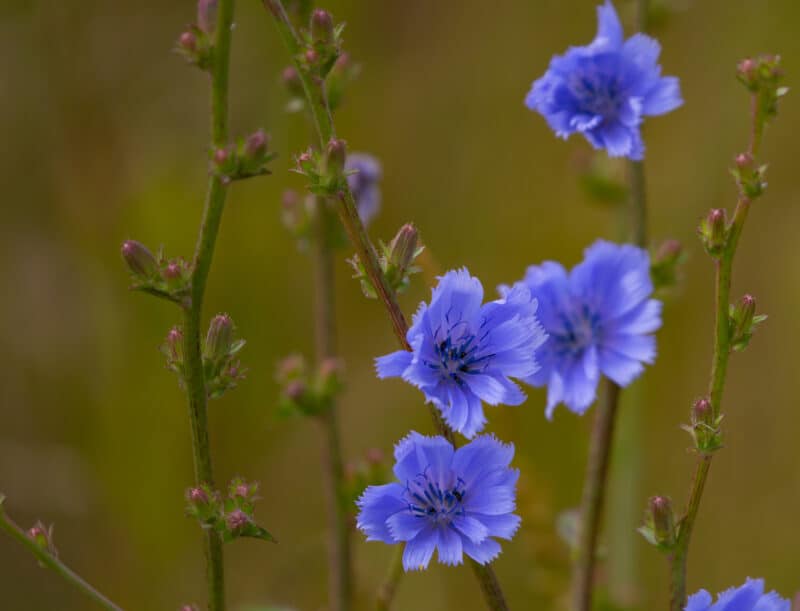Cichorium intybus or common chicory is a member of the Asteraceae (daisy) family. It’s a perennial herb that typically has blue flowers – rare instances of chicory plants have white or pink flowers.
The common chicory is native to Europe and the Mediterranean, and was introduced to the USA sometime in the 19th Century.

There are a variety of uses for chicory, but is chicory actually edible?
Yes, all parts of the chicory plant are edible. Due to their woody smell and nutty flavor, the roots are typically used to make coffee. The leaves and shoots can be eaten raw or cooked and served as or added to a salad.
Certain breweries add a touch of chicory to their stouts to give them a coffee-like flavor.
What is Chicory?
As previously stated, the common chicory plant is native to Europe and the Mediterranean and came to the USA in the 19th Century. It’s grown in the Netherlands, Belgium, Germany, France, and to a lesser extent in North America.
The plant features a fleshy taproot with a long, rigid stem and lobed, toothed leaves which resemble the leaves of a dandelion plant, and which grow around the base of the stem. Chicory plants typically reach heights of 3 to 5 feet (1 – 1.5 meters).
Culinary Uses
There are a few different culinary uses for chicory – both the roots and the leaves. These uses include:
- Coffee colorant/flavorants
- Beer stout flavorants
- Salad leaves
I happen to enjoy my coffee, so imagine my delight and amusement when I read that chicory roots can be used as a caffeine-free coffee substitute. It’s also added to certain coffees to add color and enhance the flavor. Certain breweries add a touch of chicory to their stouts to give them a coffee-like flavor.
As far as the leaves go, you can eat them wild if you like but they’re incredibly bitter which is appreciated in parts of Italy and Southern India. The leaves are used as a spinach substitute in Albania, and served as a salad coated in olive oil and lemon juice in Greece. If you want to reduce the bitterness, you can cook the leaves and discard the water.
Another culinary use that is aimed at livestock is as a fodder plant.
Which Parts can be Eaten?
All parts of the chicory plant are edible. Due to their woody smell and nutty flavor, the roots are typically used to make coffee – in fact, chicory coffee is considered a staple of New Orleans – but you can also cook them like parsnips.
The leaves and shoots can be eaten raw or cooked and served as or added to a salad.
Nutritional Value
What is the nutritional value of chicory? Well, I’m glad you asked; here’s a quick breakdown:
| Protein | 0.5 g |
| Calories | 6.7 g |
| Carbohydrates | 1.4 g |
| Omega-3 Fatty Acids | 5.5 mg |
| Omega-6 Fatty Acids | 32.5 mg |
| Vitamin A | 1658 IU |
| Vitamin C | 7.0 mg |
| Vitamin E | 0.7 mg |
| Vitamin K | 86.3 mcg |
| Niacin | 0.1 mg |
| Folate | 31.9 mcg |
| Pantothenic Acid- | 0.3 mg |
| Choline | 3.7 mg |
| Calcium | 29.0 mg |
| Iron | 0.3 mg |
| Magnesium | 8.7 mg |
| Phosphorus | 13.6 mg |
| Potassium | 122 mg |
| Sodium | 13.0 mg |
| Zinc | 0.1 mg |
| Copper | 0.1 mg |
| Manganese | 0.1 mg |
| Selenium | 0.1 mcg |
| Water | 26.7 g |
| Caffeine | 0.0 mg |
The Bottom Line
Okay, so to recap:
- Yes, chicory is edible.
- It’s used in coffee as a flavorant and colorant, beer flavorant for stouts, and in food.
- Food-wise, the leaves can be eaten either raw or cooked, and are typically added to or served as a salad.

Greg is a South African farmer and homesteader who’s been around animals ever since he can remember. He’s also an avid camper and hiker.
